小学英语优秀教研活动案例汇总-共13页
小学英语优秀教研活动案例
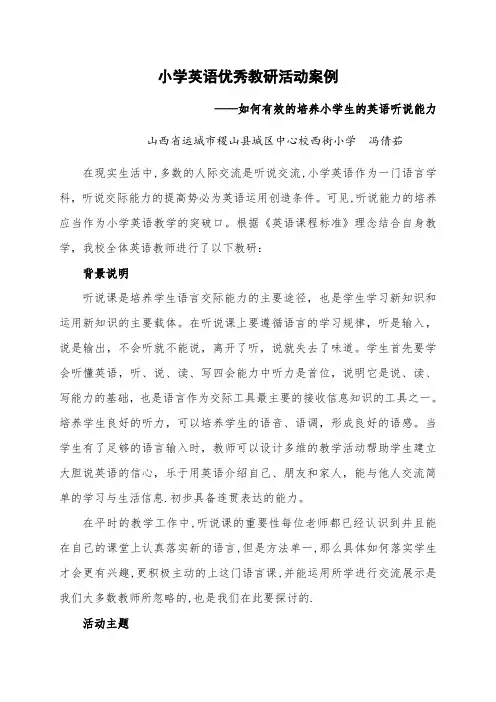
小学英语优秀教研活动案例——如何有效的培养小学生的英语听说能力山西省运城市稷山县城区中心校西街小学冯倩茹在现实生活中,多数的人际交流是听说交流,小学英语作为一门语言学科,听说交际能力的提高势必为英语运用创造条件。
可见,听说能力的培养应当作为小学英语教学的突破口。
根据《英语课程标准》理念结合自身教学,我校全体英语教师进行了以下教研:背景说明听说课是培养学生语言交际能力的主要途径,也是学生学习新知识和运用新知识的主要载体。
在听说课上要遵循语言的学习规律,听是输入,说是输出,不会听就不能说,离开了听,说就失去了味道。
学生首先要学会听懂英语,听、说、读、写四会能力中听力是首位,说明它是说、读、写能力的基础,也是语言作为交际工具最主要的接收信息知识的工具之一。
培养学生良好的听力,可以培养学生的语音、语调,形成良好的语感。
当学生有了足够的语言输入时,教师可以设计多维的教学活动帮助学生建立大胆说英语的信心,乐于用英语介绍自己、朋友和家人,能与他人交流简单的学习与生活信息.初步具备连贯表达的能力。
在平时的教学工作中,听说课的重要性每位老师都已经认识到并且能在自己的课堂上认真落实新的语言,但是方法单一,那么具体如何落实学生才会更有兴趣,更积极主动的上这门语言课,并能运用所学进行交流展示是我们大多数教师所忽略的,也是我们在此要探讨的.活动主题如何有效的培养小学生的英语听说能力研讨时间2015年12月2日研讨方式示范课展示----本校教师议课—--专家点评活动成员解武娟(县教研室小教组英语教研员)、西街小学全体英语教师实施过程一、示范课展示由冯倩茹执教“Trees”一课教学内容牛津英语6A Unit11 Trees教学目标1.学生能听懂并会读look and learn 的生词。
2.通过listen and say 关于书的重要性的对话,帮助学生掌握核心句型We get...from...和We use ...to ...3.学生会操练核心句型,引导学生初步运用核心句型问答。
小学英语教研活动记实(3篇)
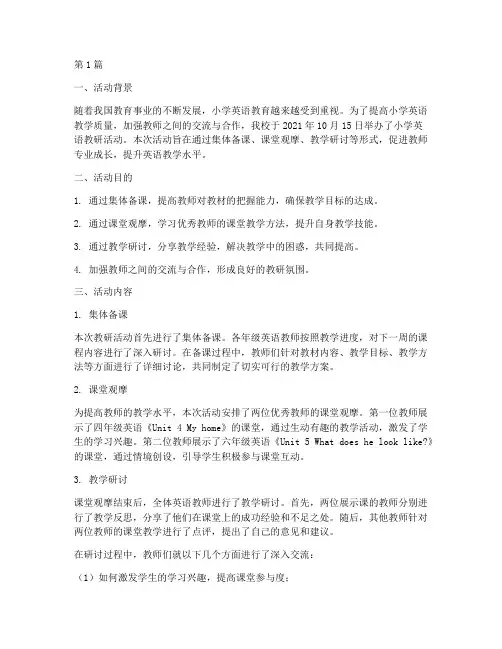
第1篇一、活动背景随着我国教育事业的不断发展,小学英语教育越来越受到重视。
为了提高小学英语教学质量,加强教师之间的交流与合作,我校于2021年10月15日举办了小学英语教研活动。
本次活动旨在通过集体备课、课堂观摩、教学研讨等形式,促进教师专业成长,提升英语教学水平。
二、活动目的1. 通过集体备课,提高教师对教材的把握能力,确保教学目标的达成。
2. 通过课堂观摩,学习优秀教师的课堂教学方法,提升自身教学技能。
3. 通过教学研讨,分享教学经验,解决教学中的困惑,共同提高。
4. 加强教师之间的交流与合作,形成良好的教研氛围。
三、活动内容1. 集体备课本次教研活动首先进行了集体备课。
各年级英语教师按照教学进度,对下一周的课程内容进行了深入研讨。
在备课过程中,教师们针对教材内容、教学目标、教学方法等方面进行了详细讨论,共同制定了切实可行的教学方案。
2. 课堂观摩为提高教师的教学水平,本次活动安排了两位优秀教师的课堂观摩。
第一位教师展示了四年级英语《Unit 4 My home》的课堂,通过生动有趣的教学活动,激发了学生的学习兴趣。
第二位教师展示了六年级英语《Unit 5 What does he look like?》的课堂,通过情境创设,引导学生积极参与课堂互动。
3. 教学研讨课堂观摩结束后,全体英语教师进行了教学研讨。
首先,两位展示课的教师分别进行了教学反思,分享了他们在课堂上的成功经验和不足之处。
随后,其他教师针对两位教师的课堂教学进行了点评,提出了自己的意见和建议。
在研讨过程中,教师们就以下几个方面进行了深入交流:(1)如何激发学生的学习兴趣,提高课堂参与度;(2)如何根据学生的实际情况,调整教学策略,使教学目标得以达成;(3)如何运用多种教学方法,提高英语教学效果;(4)如何关注学生的个体差异,实施分层教学。
4. 教研总结最后,教研组长对本次活动进行了总结。
她指出,本次教研活动取得了圆满成功,达到了预期目标。
小学生英语教研活动展示(3篇)
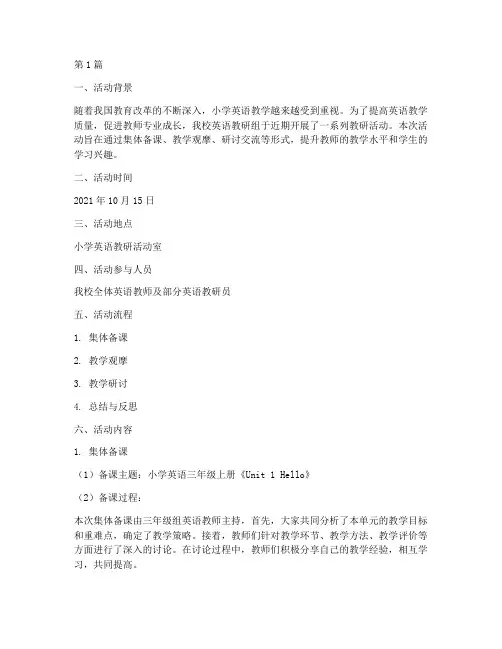
第1篇一、活动背景随着我国教育改革的不断深入,小学英语教学越来越受到重视。
为了提高英语教学质量,促进教师专业成长,我校英语教研组于近期开展了一系列教研活动。
本次活动旨在通过集体备课、教学观摩、研讨交流等形式,提升教师的教学水平和学生的学习兴趣。
二、活动时间2021年10月15日三、活动地点小学英语教研活动室四、活动参与人员我校全体英语教师及部分英语教研员五、活动流程1. 集体备课2. 教学观摩3. 教学研讨4. 总结与反思六、活动内容1. 集体备课(1)备课主题:小学英语三年级上册《Unit 1 Hello》(2)备课过程:本次集体备课由三年级组英语教师主持,首先,大家共同分析了本单元的教学目标和重难点,确定了教学策略。
接着,教师们针对教学环节、教学方法、教学评价等方面进行了深入的讨论。
在讨论过程中,教师们积极分享自己的教学经验,相互学习,共同提高。
(3)备课成果:通过集体备课,教师们对本单元的教学有了更深入的了解,形成了较为完善的教学方案。
以下是本次集体备课的成果:- 教学目标:学生能够正确发音、理解并运用本单元的词汇和句型,提高英语口语表达能力。
- 教学重难点:正确发音、理解并运用句型。
- 教学方法:情景教学法、游戏教学法、任务型教学法等。
- 教学评价:课堂参与度、口语表达、作业完成情况等。
2. 教学观摩(1)观摩教师:三年级组英语教师(2)观摩内容:三年级上册《Unit 1 Hello》(3)观摩过程:观摩课由三年级组英语教师进行,课堂上,教师运用多种教学方法,激发学生的学习兴趣。
教师通过创设情境、设置游戏、小组合作等方式,让学生在轻松愉快的氛围中学习英语。
在课堂上,学生积极参与,课堂气氛活跃。
3. 教学研讨(1)研讨主题:如何提高小学英语课堂教学效果(2)研讨过程:观摩课后,全体英语教师进行了教学研讨。
大家针对观摩课的优点和不足进行了深入分析,并提出了改进措施。
以下是研讨的主要内容:- 优点:教师教学态度认真,课堂气氛活跃,学生参与度高。
英语教研组教研活动案例
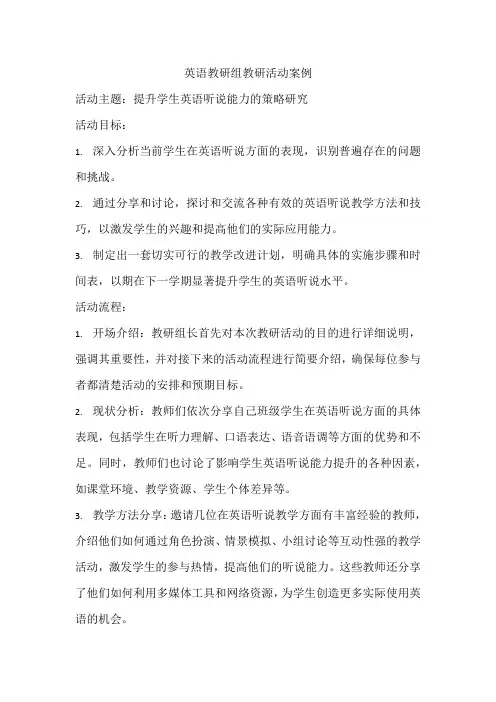
英语教研组教研活动案例活动主题:提升学生英语听说能力的策略研究活动目标:1.深入分析当前学生在英语听说方面的表现,识别普遍存在的问题和挑战。
2.通过分享和讨论,探讨和交流各种有效的英语听说教学方法和技巧,以激发学生的兴趣和提高他们的实际应用能力。
3.制定出一套切实可行的教学改进计划,明确具体的实施步骤和时间表,以期在下一学期显著提升学生的英语听说水平。
活动流程:1.开场介绍:教研组长首先对本次教研活动的目的进行详细说明,强调其重要性,并对接下来的活动流程进行简要介绍,确保每位参与者都清楚活动的安排和预期目标。
2.现状分析:教师们依次分享自己班级学生在英语听说方面的具体表现,包括学生在听力理解、口语表达、语音语调等方面的优势和不足。
同时,教师们也讨论了影响学生英语听说能力提升的各种因素,如课堂环境、教学资源、学生个体差异等。
3.教学方法分享:邀请几位在英语听说教学方面有丰富经验的教师,介绍他们如何通过角色扮演、情景模拟、小组讨论等互动性强的教学活动,激发学生的参与热情,提高他们的听说能力。
这些教师还分享了他们如何利用多媒体工具和网络资源,为学生创造更多实际使用英语的机会。
4.小组讨论:教师们分成几个小组,每组针对特定的教学场景或学生群体,讨论如何将分享的教学方法和技巧融入到自己的课堂中。
小组成员积极交流意见,提出创新的教学方案,并对可能遇到的困难进行预测和讨论,共同寻找解决方案。
5.案例分析:选取几个典型的英语听说教学案例,包括成功的案例和需要改进的案例,进行深入分析。
教师们从教学设计、实施过程、学生反馈等方面进行讨论,分析每个案例的优缺点,并探讨如何在自己的教学实践中避免类似问题的发生。
6.制定行动计划:每个小组根据讨论结果,制定出一套具体的教学改进措施和实施计划。
这些计划包括具体的教学活动、所需资源、预期目标和评估方法等,确保每项措施都有明确的执行标准和时间安排。
7.活动总结:教研组长对本次教研活动进行总结,肯定了教师们的积极参与和创造性思维,并对下一步的工作进行了详细部署。
小学英语组教研活动案例
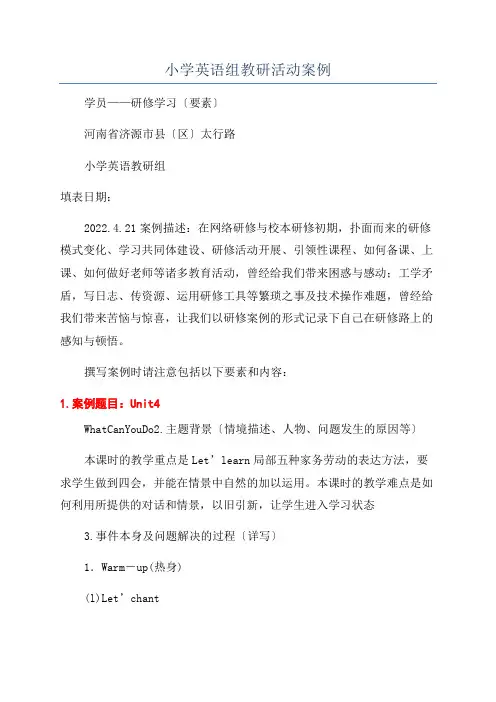
小学英语组教研活动案例学员——研修学习〔要素〕河南省济源市县〔区〕太行路小学英语教研组填表日期:2022.4.21案例描述:在网络研修与校本研修初期,扑面而来的研修模式变化、学习共同体建设、研修活动开展、引领性课程、如何备课、上课、如何做好老师等诸多教育活动,曾经给我们带来困惑与感动;工学矛盾,写日志、传资源、运用研修工具等繁琐之事及技术操作难题,曾经给我们带来苦恼与惊喜,让我们以研修案例的形式记录下自己在研修路上的感知与顿悟。
撰写案例时请注意包括以下要素和内容:1.案例题目:Unit4WhatCanYouDo2.主题背景〔情境描述、人物、问题发生的原因等〕本课时的教学重点是Let’learn局部五种家务劳动的表达方法,要求学生做到四会,并能在情景中自然的加以运用。
本课时的教学难点是如何利用所提供的对话和情景,以旧引新,让学生进入学习状态3.事件本身及问题解决的过程〔详写〕1.Warm-up(热身)(l)Let’chant①教师播放tart局部Let’chant的录音,让学生边听边看图并能理解歌谣的意思。
②反复听2-3遍后,可带着学生小声重复。
③拍手掌握节奏,教师将Mike变本钱班同学的名字进行提问:Tom,Tom,whatcanyoudo?可提问3-4人。
(2)口语练习谁的本领大:①男、女生进行比赛,分别用Ican…来介绍自己会做的事,看看谁的本领大。
②请同学边说边用动作表示,重复不加分,哪组说的最多即为获胜组。
2.Preentation(新课呈现)(l)Start①教师出示图片请同学们观看,Oh,omanyanimal!Whatcantheydo②角色扮演:教师提问,Bird,bird,whatcanyoudo请学生挑选自己喜欢的动物边说边做动作。
(2)Le t’learn①学生观看教材的背景图,教师指图,用夸张的语气介绍:She’Lucy.Thiiherroom.She’helpful!AreyouhelpfulWhatcanyoudo②然后播放课件或动画,带着全班一起反复跟读5个词组,提醒学生注意语音语调。
小学英语教研活动详案(3篇)
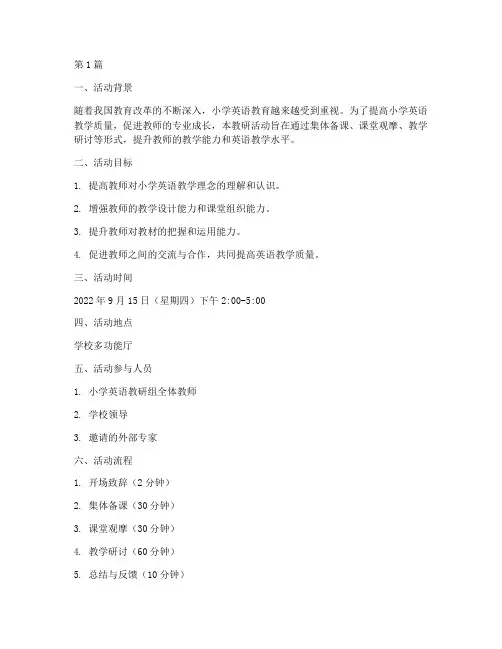
第1篇一、活动背景随着我国教育改革的不断深入,小学英语教育越来越受到重视。
为了提高小学英语教学质量,促进教师的专业成长,本教研活动旨在通过集体备课、课堂观摩、教学研讨等形式,提升教师的教学能力和英语教学水平。
二、活动目标1. 提高教师对小学英语教学理念的理解和认识。
2. 增强教师的教学设计能力和课堂组织能力。
3. 提升教师对教材的把握和运用能力。
4. 促进教师之间的交流与合作,共同提高英语教学质量。
三、活动时间2022年9月15日(星期四)下午2:00-5:00四、活动地点学校多功能厅五、活动参与人员1. 小学英语教研组全体教师2. 学校领导3. 邀请的外部专家六、活动流程1. 开场致辞(2分钟)2. 集体备课(30分钟)3. 课堂观摩(30分钟)4. 教学研讨(60分钟)5. 总结与反馈(10分钟)七、活动内容1. 开场致辞由教研组长主持,简要介绍本次教研活动的目的、意义和议程。
2. 集体备课(1)选课:确定本次教研活动的教学内容,由教研组长根据教学进度和教材内容,选定一节课进行集体备课。
(2)讨论:教研组成员围绕选定的教学内容,共同讨论教学目标、教学重难点、教学策略、教学方法等。
(3)分工:根据讨论结果,将备课任务分配给每位教研组成员。
(4)撰写教案:每位教研组成员根据分工,撰写教案。
3. 课堂观摩(1)由一位教研组成员进行公开课展示。
(2)其他教研组成员观摩并记录课堂情况。
4. 教学研讨(1)观摩教师进行说课,介绍自己的教学设计思路和实施过程。
(2)其他教研组成员进行评课,提出改进意见和教学建议。
(3)外部专家对课堂观摩和教学研讨进行点评,给出专业指导。
5. 总结与反馈(1)教研组长对本次教研活动进行总结,肯定优点,指出不足。
(2)教师代表分享自己的收获和体会。
(3)学校领导对本次活动进行总结,并提出期望和要求。
八、活动预期效果1. 通过集体备课,提高教师的教学设计能力和课堂组织能力。
2. 通过课堂观摩和教学研讨,促进教师之间的交流与合作,共同提高英语教学质量。
小学英语科教研活动(3篇)
第1篇一、活动背景随着我国教育改革的不断深入,小学英语教学越来越受到重视。
为了提高小学英语教学质量,培养具有国际视野的学生,我校决定开展小学英语科教研活动。
本次活动旨在通过研讨、交流、实践等形式,提升英语教师的教学水平,促进学生英语学习兴趣,提高英语教学效果。
二、活动目标1. 提高英语教师的教学素养,丰富教学手段,提升教学效果。
2. 激发学生学习英语的兴趣,提高学生的英语综合运用能力。
3. 促进教师之间的交流与合作,形成良好的教研氛围。
三、活动内容1. 教学研讨:针对英语教学中的重点、难点问题进行研讨,分享教学经验,共同探讨解决方法。
2. 课堂教学观摩:组织教师观摩优秀教师的课堂教学,学习其教学方法和技巧。
3. 教学案例分析:结合实际教学案例,分析教学过程中的优点和不足,提出改进措施。
4. 教学资源分享:收集和整理优秀的英语教学资源,供教师参考和借鉴。
5. 教学技能培训:开展英语教师教学技能培训,提高教师的专业素养。
四、活动安排1. 活动时间:每月最后一个周五下午2. 活动地点:学校多功能厅3. 活动流程:(1)14:30-14:40 集合,签到(2)14:40-15:00 教研组长发言,布置活动任务(3)15:00-15:50 教学研讨,教师分组讨论(4)15:50-16:10 课堂教学观摩,优秀教师展示(5)16:10-16:30 教学案例分析,教师分享经验(6)16:30-17:00 教学资源分享,教师交流心得(7)17:00-17:10 教学技能培训,总结发言五、活动要求1. 全体英语教师参加活动,确保活动顺利进行。
2. 教师积极参与研讨,认真撰写活动总结。
3. 教研组长负责活动组织、协调和总结。
4. 教师在活动中要遵守纪律,尊重他人意见。
六、预期效果1. 提高英语教师的教学水平,形成良好的教研氛围。
2. 激发学生学习英语的兴趣,提高学生的英语综合运用能力。
3. 促进学校英语教学质量的整体提升。
英语教研活动案例分享(3篇)
第1篇IntroductionThe continuous development of English language teaching (ELT) requires educators to stay updated with the latest methodologies, strategies, and resources. Collaborative教研 activities provide a platform for teachers to share experiences, learn from each other, and collectively improve their teaching practices. This case study explores a series ofsuccessful English教研活动 conducted in a primary school, highlighting the key aspects of the activities, their impact on teacher development, and the subsequent improvements in student learning outcomes.BackgroundThe primary school in question has a diverse student population, with a majority of students from non-English speaking backgrounds. The school administration recognized the need for continuous professional development (CPD) to enhance the quality of English language instruction. As a result, a dedicated team of teachers was formed to organize and implement a series of教研活动 aimed at fostering collaboration, knowledge sharing, and skill development.Case Description1. Pre-Activity PlanningThe教研活动筹备阶段,团队成员通过以下步骤确保活动的顺利进行:- Identifying Objectives: The team established clear learning objectives for each activity, focusing on areas identified as needing improvement, such as vocabulary development, reading comprehension, and speaking skills.- Selecting Topics: Based on the objectives, relevant topics were chosen, such as "Effective Vocabulary Teaching Strategies" and "EngagingStudents in Reading Activities."- Scheduling: A schedule was created to allocate time for each activity, ensuring that teachers could participate without disrupting their regular teaching responsibilities.- Resource Allocation: Necessary resources, such as handouts, videos, and online materials, were gathered and organized for the activities.2. Activity ImplementationThe教研活动主要包括以下几种形式:- Workshops: Short, focused sessions where teachers learned about specific teaching strategies and techniques.- Peer Observations: Teachers observed each other's classes and provided constructive feedback, fostering a culture of continuous improvement.- Collaborative Lesson Planning: Teachers worked together to design and implement new lesson plans, sharing ideas and resources.- Guest Speakers: Experts in the field of ELT were invited to sharetheir insights and experiences with the team.3. Post-Activity ReflectionAfter each activity, the team engaged in reflective discussions to evaluate the effectiveness of the activities and identify areas for improvement:- Feedback Collection: Teachers were asked to provide feedback on the activities, including what they found helpful and what could be improved.- Data Analysis: Student performance data was analyzed to assess the impact of the教研活动 on learning outcomes.- Action Planning: Based on the feedback and data analysis, a plan was developed to address any identified issues and further enhance the effectiveness of future activities.Impact on Teacher DevelopmentThe教研活动对教师的专业发展产生了积极影响:- Increased Knowledge: Teachers gained a deeper understanding of various teaching strategies and methodologies.- Improved Confidence: Collaborative activities helped teachers feel more confident in their teaching abilities and decision-making.- Enhanced Collaboration: The activities fostered a sense of community among teachers, leading to increased collaboration in and out of the classroom.- Continuous Improvement: Teachers developed a mindset of continuous improvement, always seeking to refine their teaching practices.Impact on Student Learning OutcomesThe positive impact of the教研活动 on student learning outcomes was evident:- Improved Language Skills: Students showed significant improvement in vocabulary, reading comprehension, and speaking skills.- Increased Engagement: Students became more engaged in English language learning, leading to higher motivation and participation.- Enhanced Learning Environment: The activities contributed to a more supportive and inclusive learning environment, where students felt comfortable expressing themselves.ConclusionThe case study demonstrates the value of collaborative教研活动 in enhancing English language teaching. By fostering collaboration, knowledge sharing, and skill development, these activities have led to significant improvements in both teacher professional development and student learning outcomes. As a result, the school administration has recognized the importance of ongoing support for such activities and has committed to providing further resources and opportunities for teacher growth.Recommendations for Future ActivitiesTo ensure the ongoing success of future教研活动, the following recommendations are proposed:- Regular Scheduling: Establish a regular schedule for教研活动,ensuring that teachers have time to participate and reflect on their practice.- Diverse Topics: Offer a variety of topics to cater to the diverse needs and interests of teachers.- Professional Development: Provide opportunities for teachers to engage in further professional development, such as workshops and conferences.- Data-Driven Decision Making: Use student performance data to inform the design and implementation of future activities.By continuing to invest in collaborative教研活动, schools can create a supportive and dynamic learning environment that promotes excellence in English language teaching and learning.第2篇IntroductionThe English language teaching (ELT) field is constantly evolving, with new methodologies, technologies, and research findings shaping the way educators approach language learning. This case study presents a successful English教研活动,which aimed to enhance the quality of English teaching and learning through collaborative research and development. The activity was conducted over a period of six months and involved a diverse group of teachers, educational experts, and students from a secondary school in China.BackgroundThe secondary school in question had been facing several challenges in its English language program. These included a lack of teacher training opportunities, outdated teaching materials, and a limited understanding of current ELT trends. The administration recognized the need for acomprehensive approach to improve the English language program and decided to organize a research and development (R&D) initiative.ObjectivesThe primary objectives of the R&D initiative were:1. To enhance teacher knowledge and skills in modern ELT methodologies.2. To update the school's English curriculum and teaching materials.3. To integrate technology into English language teaching.4. To improve student engagement and learning outcomes in English.MethodologyThe R&D initiative was structured around the following phases:1. Research Phase: A literature review was conducted to identify current trends in ELT and to understand the best practices for English language teaching. This phase also involved gathering feedback from teachers and students about the existing program.2. Development Phase: Based on the research findings, a team of teachers and educational experts was formed to develop new teaching materials and methodologies. This team also received training on modern ELT techniques and technology integration.3. Implementation Phase: The new teaching materials and methodologies were piloted in selected classrooms. Feedback was collected from teachers and students to assess the effectiveness of the new approaches.4. Reflection and Improvement Phase: The data collected during the implementation phase was analyzed, and adjustments were made to the teaching materials and methodologies as needed.Case Study: The R&D InitiativePhase 1: ResearchThe research phase began with a comprehensive literature review that included studies on the following topics:- The effectiveness of communicative language teaching (CLT) in secondary schools.- The role of technology in English language learning.- Strategies for engaging students in English classes.- The impact of formative assessment on student learning outcomes.The research also involved surveys and interviews with teachers and students to gather their insights and identify areas for improvement.Phase 2: DevelopmentBased on the research findings, the development phase focused on the following activities:- Teacher Training: A series of workshops were organized to train teachers on modern ELT methodologies, including CLT, task-based learning, and project-based learning.- Curriculum Development: A new curriculum was developed that incorporated a variety of teaching and learning activities, such asgroup work, role-playing, and multimedia presentations.- Teaching Materials: New teaching materials were created, including lesson plans, activity sheets, and interactive digital resources.Phase 3: ImplementationThe new teaching materials and methodologies were implemented in two English classes. The following strategies were employed to ensure a smooth transition:- Training: Teachers received additional training on how to use the new materials and methodologies effectively.- Support: A support team was established to assist teachers with any challenges they encountered during the implementation process.- Feedback: Regular feedback sessions were held with teachers and students to assess the effectiveness of the new approaches.Phase 4: Reflection and ImprovementThe data collected during the implementation phase revealed several areas of improvement:- The new teaching materials were well-received by both teachers and students, with a notable increase in student engagement.- The integration of technology into the curriculum helped to make lessons more interactive and engaging.- Some teachers reported that they needed more time to adapt to the new methodologies, so additional training sessions were scheduled.ConclusionThe R&D initiative successfully enhanced the quality of English language teaching at the secondary school. The collaboration between teachers, educational experts, and students led to the development of innovative teaching materials and methodologies that improved student engagement and learning outcomes. This case study highlights the importance of collaborative research and development in the field of ELT and demonstrates the potential for continuous improvement through a commitment to professional development and student-centered teaching practices.Reflections and Recommendations- Continuous Professional Development: It is crucial for teachers to engage in continuous professional development to stay updated with the latest ELT trends and methodologies.- Technology Integration: The effective integration of technology into ELT can significantly enhance student engagement and learning outcomes.- Collaborative Efforts: Collaborative research and development initiatives can lead to innovative teaching practices and better student learning experiences.- Data-Driven Decision Making: The use of data to inform teaching and learning practices can help educators make informed decisions and improve their programs over time.By adopting these strategies and focusing on collaborative research and development, educational institutions can continue to enhance thequality of English language teaching and learning.第3篇Introduction:In the ever-evolving field of education, continuous professional development (CPD) is crucial for teachers to stay updated with thelatest pedagogical approaches and strategies. This case study focuses on a successful English教研活动 held at XYZ High School, aimed at enhancing the quality of English language teaching. The activity was designed to foster collaboration among teachers, share innovative teaching methods, and ultimately improve student learning outcomes.Background:The English department at XYZ High School had been facing several challenges, including a lack of diversity in teaching methods, limited resources for student engagement, and a general need for professional growth among the faculty. Recognizing these issues, the department decided to organize a series of教研 activities to address these challenges and promote a more collaborative and student-centered approach to teaching English.Objective:The primary objective of the教研活动 was to:1. Foster collaboration and communication among English teachers.2. Introduce and explore innovative teaching methods and resources.3. Enhance the overall quality of English language teaching.4. Provide opportunities for teachers to reflect on their practice and implement positive changes.Activity Design:The教研活动 was structured into three main phases: planning, implementation, and reflection.Phase 1: Planning1. Identifying Goals: The department chair, in collaboration with the English faculty, identified specific goals for the教研活动. These included improving student engagement, incorporating technology into lessons, and enhancing speaking and listening skills.2. Formation of Groups: Teachers were divided into small groups based on their teaching levels and areas of expertise. Each group was responsible for researching a specific topic and developing a presentation.3. Resource Allocation: The school provided resources such as a library of educational materials, access to online platforms, and a budget for materials needed for the presentations.Phase 2: Implementation1. Workshops and Presentations: Each group conducted research and prepared a presentation on their chosen topic. The presentations were held during a two-day workshop, where teachers from other departments were also invited to attend.2. Interactive Sessions: During the workshops, teachers participated in interactive sessions, including role-playing, group discussions, and hands-on activities. These sessions were designed to provide practical insights into implementing the new teaching methods.3. Feedback and Discussion: After each presentation, a feedback session was held to discuss the effectiveness of the new methods and to address any concerns or questions.Phase 3: Reflection1. Self-Reflection: Teachers were encouraged to reflect on their own teaching practices and identify areas for improvement based on the new methods learned during the workshop.2. Peer Observation: Teachers were paired up to observe each other's lessons and provide constructive feedback. This peer observation process aimed to create a supportive environment where teachers could learn from each other.3. Continuous Improvement: The department established a schedule for regular follow-up meetings to monitor the progress of implementing new teaching methods and to address any challenges that may arise.Results:The教研活动 was highly successful in achieving its objectives. The following outcomes were observed:1. Increased Collaboration: Teachers reported a significant increase in collaboration and communication among faculty members. This was evident in the sharing of resources, ideas, and best practices.2. Enhanced Teaching Methods: Teachers began incorporating innovative teaching methods, such as project-based learning, flipped classrooms, and gamification, into their lessons. These methods resulted in increased student engagement and improved learning outcomes.3. Professional Growth: Teachers felt more confident in their teaching abilities and were motivated to continue their professional development. The department received positive feedback from teachers regarding the impact of the教研活动 on their growth as educators.4. Improved Student Performance: Student performance in English language classes improved, as evidenced by higher scores on assessments and increased participation in class activities.Conclusion:The successful implementation of the English教研活动 at XYZ High School serves as a testament to the power of collaboration and continuousprofessional development in enhancing the quality of English language teaching. By fostering a supportive environment and providing opportunities for teachers to learn from each other, the activity not only improved teaching methods but also had a positive impact on student learning outcomes. As educators, it is essential to embrace such collaborative initiatives to ensure the continuous growth and success of our students.。
小学英语优秀教研活动案例
小学英语优秀教研活动案例主题:学习英语应用于日常生活目标:通过饮食、购物、旅行等情境,学生能够灵活运用英语进行交流,能够熟练运用所学知识解决实际问题。
一、活动前准备:1.教师将课文与生活情境结合,设计有关饮食、购物、旅行等情境的对话。
例如:在饭店点菜、在超市购物、在火车站问路等。
2.教师准备PPT或者教学课件,展示与课文相关的图片和简单对话。
二、活动步骤:1.导入:教师出示一张有关饮食、购物、旅行的图片,让学生通过图片进行交流。
例如:学生看到一张有关饭店的图片,教师问学生:“你们在饭店有过什么经历吗?你们在饭店的时候用过英语吗?”学生回答后,教师引入本节课的主题。
2.学习对话:教师通过PPT或者教学课件展示与课文相关的对话,让学生跟读对话并理解对话内容。
3.情境模拟:教师将学生分成小组,每个小组分别扮演饭店的服务员与顾客,进行模拟对话,提升学生的英语应用能力。
4.角色扮演:教师安排几对学生进行角色扮演,让他们在课文基础上自由发挥,设计新的对话,培养学生的创造力和语言表达能力。
5.实践应用:教师布置作业,要求学生通过实践运用所学知识。
例如:学生去超市购物,用英语询问价格和数量;学生去火车站问路,用英语进行交流。
三、活动结束:1.教师进行总结,梳理学生在活动中的表现,并对优秀的学生进行表扬。
2.教师布置下一次教学内容,并鼓励学生继续努力学习。
这个活动的特点是集课文学习、情境模拟和实践应用于一体,通过真实的生活情境,让学生在活动中灵活运用所学知识。
同时,通过角色扮演和自由发挥,培养学生的创造力和语言表达能力。
这样的教学模式能够激发学生的学习兴趣,提高他们的学习动力,使英语学习变得有趣而有意义。
小学英语的教研活动案例
一、活动背景随着我国教育改革的不断深入,英语教育在小学阶段的重要性日益凸显。
为了提高小学英语教学质量,促进教师专业成长,我校英语教研组定期开展教研活动。
本次教研活动以“提高小学英语课堂教学效率”为主题,旨在通过集体备课、教学观摩、经验交流等形式,提升教师的教学水平和学生的英语学习兴趣。
二、活动目标1. 提高教师对小学英语课堂教学效率的认识,明确提高教学效率的方法和途径。
2. 通过集体备课,优化教学设计,提高课堂教学质量。
3. 促进教师之间的交流与合作,共同提高教学水平。
4. 培养学生的英语学习兴趣,提高学生的英语素养。
三、活动时间与地点活动时间:2022年3月15日(星期二)下午2:00-5:00活动地点:学校多功能厅四、活动流程1. 集体备课(1)教师分组,针对某一单元进行集体备课。
(2)教师分享教学设计,互相讨论,提出改进意见。
(3)教研组长总结,对教学设计进行优化。
2. 教学观摩(1)由一位教师进行公开课展示,其他教师观摩。
(2)观摩结束后,进行评课议课,总结公开课的优点和不足。
3. 经验交流(1)教师分享在教学过程中积累的经验和心得。
(2)教研组长对教师们的分享进行点评,并提出改进建议。
4. 总结与反思(1)教研组长对本次活动进行总结,肯定成绩,指出不足。
(2)教师们对本次活动进行反思,提出改进措施。
五、活动内容1. 集体备课(1)分组情况:将英语教研组教师分为4个小组,每个小组负责某一单元的教学设计。
(2)教学设计分享:各小组将教学设计进行分享,其他教师提出意见和建议。
(3)教研组长总结:对教学设计进行优化,提出改进意见。
2. 教学观摩(1)公开课展示:由青年教师A进行公开课展示,课题为“Unit 3 My family”。
(2)评课议课:观摩结束后,其他教师对公开课进行评课议课,肯定优点,指出不足。
3. 经验交流(1)教师分享:各教师结合自身教学实践,分享教学经验和心得。
(2)教研组长点评:对教师们的分享进行点评,提出改进建议。
- 1、下载文档前请自行甄别文档内容的完整性,平台不提供额外的编辑、内容补充、找答案等附加服务。
- 2、"仅部分预览"的文档,不可在线预览部分如存在完整性等问题,可反馈申请退款(可完整预览的文档不适用该条件!)。
- 3、如文档侵犯您的权益,请联系客服反馈,我们会尽快为您处理(人工客服工作时间:9:00-18:30)。
小学英语优秀教研活动案例山西省运城市稷山县稷峰镇西街小学冯倩茹一、背景说明小学英语课标指出:英语课程要面向全体学生,注重素质教育。
课程特别强调要关注每个学生的情感,激发他们学习英语的兴趣,帮助他们建立学习的成就感和自信心,使他们在学习过程中发展综合语言运用能力,提高人文素养,增强实践能力,培养创新精神。
二、活动主题:如何有效的听课三、研讨时间:每周五早上8:00---10:00四、研讨方式:主题教研、观看名师课例、听课评课、交流反思。
五、参与人员:小学英语教研组全体成员六、研究步骤1.抓理论学习校本教研是“一种理论指导下的研究”。
不掌握一定的教育理论,不可能进行真正意义上的校本教研。
为此,我们要定期组织本校教师学习教育教学理论或要求教师利用课余时间自觉学习有关教育教学理论,特别是学习《课程标准》的一些新理念、新课程实施过程中的一些新经验等。
2.抓教材培训教材是教师赖以施教的依据,而对于教材,很多教师还不懂怎么教,这就急需进行教材培训。
通过培训,使教师能够吃透教材,用好教材。
3.抓课题研究课题研究是将教研与科研有机融合的教研活动形式,其操作程序大致为:(1)选择课题。
应以问题为中心,从学校或教师实际需要出发。
把教学实践中的疑问、困惑进行归纳、筛选,确定一个讨论专题,组织交流讨论,求得问题的解决。
(2)围绕课题搜集材料,选择、整理材料。
(3)开展课题研究。
在学习和研究中注意理论与实践、教学与科研、教师研究与同伴互助等相结合。
(4)课题研究结题。
教师要完成课题的研究报告或论文,总结教育教学经验,并反思教学中的不足,今后进一步进行探讨。
4.抓课例研究课例研究是以一两节课例展示的形式开展的一种教研活动。
研讨内容包括:听课、说课、评课,肯定好的、可借鉴的地方,提出建设性意见等。
5.抓教学反思反思是一种教师改进教学策略、不断提升自己教学水平的好方法,是不断提高自身教育教学素养的过程。
为此,我们强调教师勤写教后反思或随笔,及时记录教学过程成功、失败之处,记录课堂意外收获,做好课后“备课”。
教后反思书写形式上灵活多样,篇幅上有话则长、无话则短,但一定要有实效性。
6. 抓评价激励例如:在每一次教研活动之后,可以评选讲课能手、说课能手、评课能手;还可以从教研组中挑选一人发言,来评价他的优点,这一活动形式,既训练了教师的口语表达能力,同时激励了教师,给予教师许多的自信心。
教研工作是一项务实、创新且具有挑战性的工作,在具体工作中需要我们积极地去探索教研的方法和途径,投入大量的精力去组织开展教研活动,为教师教学中的疑难杂症开方。
相信在我们的共同努力下,我校的校本教研工作也一定会做得务实、高效、有声有色。
七、实施的过程为了提高教研组工作成效,我们每周至少一人做组内研究课,全组教师听课,周二、周五对该教师的说课、授课进行评课与反思,再集体备课,做到每个年级的集体备课定时间、定地点、有分工、有记录,对于每次的校本教研活动材料保存齐全,规范落实教学工作;每学期至少开设两次校内英语学科讲座,如理论学习、案例分析等,得到老师们的一致认可。
经过不断地外出观摩、学习与反思,大家都能够积极进行新课程教改实验,通过反复实践、反思、总结,功夫不负有心人,我们终于形成了适合本校特色的英语教学模式。
1、提高自身的专业素养。
本来我认为我们每一个英语教师都有足够的能力去教好我们的小学英语课程。
但是通过这次活动,我觉得这远远不够。
人无完人,我们还要不断地学习,不断地丰富自己。
对于我来说,我觉得我还有很多东西需要加强。
如提高口语表达能力,驾驭课堂的能力等等。
只有这样才能更好的完成教育教学工作。
2、不断完善课堂教学。
应该说每一次英语教研活动,我们都会从中汲取很多好的教学方法。
也就是说,很多英语老师在平日繁重的教学过程中,都在不断地的学习,琢磨,不断地完善自己的课堂教学,从而不断地提高课堂教学效率。
所以,虽然我们的课本不变,但是我们的英语教学不是一层不变的。
我们需要不断地改变、完善。
精心设计课堂活动,注重实效。
在教学中我们都追求一个目标——让学生学会知识并学会运用知识,感受学习英语的乐趣,不能只搞花样,而没有实效。
3、重视评价,关注学生的情感。
英语并不是只学单词、课文、句型、对话,不是知识的累加,而是一个综合体。
学生学的每一单元内容都是有思想的,都是一些很好的教育材料,我们应该让学生接受到英语的情感教育。
学生的学习压力很大,我们应该关注学生的情感态度培养。
本次英语教研活动意义重大,既并交流了经验共同进步,又增进了教师们的感情,同时体现了英语这门学科的特色。
借着这次活动使我认识到英语教学与英语国家文化、风俗等方面的融合的重要性。
此次活动为我在今后教学中指明了方向。
八、收获与反思怎样才能做好小学英语的教学工作呢?A、勇创双语教学特色,营造英语氛围1.在教学过程中尽可能少地说汉语,而是以英语为主体,利用手势、眼神、动作、音调等辅助手段来帮助学生理解教学内容;并且在教学过程中创设各种情景对话,通过直接的语言交流来帮助学生建立语感。
通过这种方式组织教学,能增加学生的语言实践机会,营造语言氛围,培养学生直接用英语思维、表达的习惯。
2.英语作为一种语言,其教学应该融入一定的情境之中。
可通过课堂表演来创造一定的语言环境,给孩子营造一方自由发展、自由发挥的天地;并且可为学生提供自主学习和交流的机会,给每位学生自我表现和自我发展的时间和空间。
3.鼓励学生通过参与体验、实践、合作、探索等方式,发展听、说、读、写的综合能力和整体素质。
要求学生在学校见到老师、同学,用英语打招呼;在英语课堂,尽可能用英语进行交流;在课外,也要鼓励孩子们尽可能使用英语。
把英语教学融入日常生活中的各个环节,让学习成为生活的一部分,让生活成为学习的延续。
4.反馈信息、即时巩固。
英语的听、说训练一定要做到反馈及时。
在教学中,学生对刚学的内容记忆犹新,印象深刻,但若不及时巩固,不仅会很快遗忘,而且会使学生在听、说中的错误与偏差得不到及时纠正,以至形成错误的思维定势和语言习惯。
B、关注学生情感,创造宽松、民主、和谐的教学氛围1.尊重每个学生,鼓励他们积极尝试,及时发现他们的进步并给予相应的表扬,保护他们的自尊心和积极性。
2.创设各种合作学习活动,促进学生互相学习、互相帮助、体验成功、合作发展。
3.关注后进生和性格内向的学生,尽可能为他们提供正确表现自我的机会,让每一次小小的突破成为他们进步的基石4.建立融洽的师生关系,经常和学生一起交流和探索,了解学生所想所需,做到教学相长。
C、加强学习方法指导,帮助学生学会学习1.积极创造条件,让每个学生都参与到学习活动中来。
2.结合语言情境,让学生通过实践和运用来深化学习。
3.进行自我评价,根据各自的不同状况进行查漏补缺。
D、实行激励评价,使学生树立学习英语的信心1.注重教师的客观性评价,对学生学习过程中的点滴进步给予及时的肯定和激励。
2.重视学生的主观性评价,让学生通过分析,通过比较,认识自己的优势和不足,明确努力的方向。
小学英语教学的目标是要通过听、说、读、写训练,帮助学生学会如何正确使用英语,并具备一定的英语口头表达能力。
这一主线贯穿整个教学的全过程。
其中,听、说训练尤为重要,训练的途径也是多样化的。
儿童学习外语的方式、内容与成年人应该有所不同。
他们喜欢玩,喜欢唱歌、画画,喜欢表演和游戏;他们喜欢动手操作,喜欢探究和想象。
所以,英语教学必须根据学生的年龄阶段和性格特征,因材施教,因人施教;并且在教学过程中要联系实际,不断探索、不断实践、不断反思,这样才能在教育教学中不断进步和完善。
九、改进与设想1、把握良机,调动学生积极性,渲染英语课堂气氛,创造一个轻松愉快的学习环境,引发学生的兴趣和求知欲。
小学生这个年龄的特点是:爱说爱动,自我约束、自我控制能力不强,如果教学中忽视这些特点,单纯沿用传统教学模式,使用传统教学方法进行机械地讲解,把他们纯粹当成知识的容纳器,填鸭式地问他们灌输在他们眼中枯燥无味,冷冰冰的语法、词汇,他们便不感兴趣,因而也就谈不上学习的积极性和主动性。
目前,小学英语教学质量不佳,恐怕这是一个主要原因。
学习需要兴趣。
就某种意义上讲,学英语就更需要兴趣。
如何激发学生的学习兴趣,并保持它,使之成为他们学习的动力,正是趣味教学考虑的出发点。
2、充分钻研教材,认真备课,在各教学环节中增加趣味性。
教师对学习材料和内容的处理,一般是由易到难,逐步深入,同时要考虑到对学生学习兴趣的一定刺激程度,使学生的思想始终处于积极状态,使他们的兴趣逐步升级。
其次增加教学环节中的趣味性,教学手段的多样化也有助于使学生的兴趣得以保持。
呈现语言材料前,教师要想办法为学生创设新颖可信的情景,由此吸引学生注意力,再由该情景过渡到课本所展现的情景中,同时,合理地运用实物、图片、挂图、简笔画、现场录音、多媒体课件等,让所要呈现的情景更加直观而富有情趣。
比如在进行课文教授时,教师可用从网上下载的听说读写的英语材料、采用自制课件来进行教学,通过声、光、电的完美结合,用生动的形象、真实的画面、优美动人的语言和音乐,来丰富学生的想象力,刺激学生的兴趣和求知欲,增强学生的记忆效果,从而实现教学目标,达到教学目的。
A、注重“以人为本”,发挥学生主体作用。
过去的教学常常强调教师的主导性而把学生单纯地视为教育对象,忽视学生的主体地位;把学生的头脑看作是可以填充知识的容器,忽视教学特点,无视学生的主观能动性。
教师应把小学生看作是具有成长潜能的生命体,其内部蕴藏着主体发展的机制,认识到教学的目的在于开发学生的潜力,驱动其主体的发展机制,使之成长、成熟。
“以人为本”的理念在教育界越来越深入人心。
在教育过程中,以学生为中心,充分发挥学生的主体性已成为广大教师所热衷的教学方法。
母语习得研究及外语学习研究均证实:外语教学中的重点不再应该是“我们该教些什么”,而应是“我们如何在课堂教学中创造这些条件”。
新课程标准强调的是学生“能干什么”,因此,我们在教学过程中应充分体现学生的主动性和创造性,增强学生使用英语的能力。
B、建立新型师生关系,重视师生情感交流,培养兴趣。
师生关系是以基本的人性观为前提的。
如果教育者认为,人的天性是懒惰的,不思进取的,需要严格教诲才能启迪良知,那么权威型的师生关系应该是最为有效的。
传统的师道尊严,便是权威型的师生关系的体现。
现代教育观则认为人的本性是积极的、向上的,具有生长与进取的潜力,教育的目的是开发人的潜能、促进人的健全发展,而权威型的师生关系无疑会扼杀儿童的创造力与禀赋。
在教学过程中,耐心是至关重要的。
它是一位教师良好行为的体现。
教师的工作是解决学生不同程度上的问题,其中除了教学上的,还有心灵上的。
育人的工作是辛苦的,对待形形色色的问题,不计其数的学生,都要用一颗热情的心耐心地去做。
